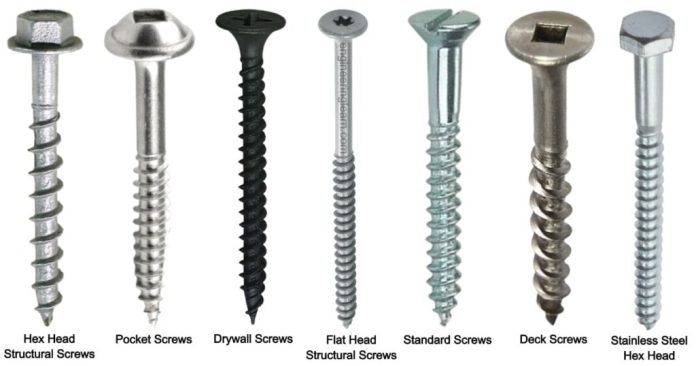You might be a DIY person who knows a bit about the tools needed for a job or a complete novice when it comes to things of that nature. Some people can even get confused over screws versus nails for a project. Screws are classified as sturdy fasteners that come in many materials, shapes, and sizes. This article will delve into the different types of screws and their uses so you will be well-equipped in choosing the right one for a variety of applications.
Screw Characteristics
Screws might look like nails, but they have different attributes like their distinctively shaped heads, ridges, and the equipment that is used to fasten them. A drill or screwdriver is used to secure screws (dependent upon the task). If the project has pre-made holes, for example, to put together furniture, a screwdriver is an ideal tool for the job. If you need to pierce material like wood (and other materials), a drill is up for that assignment.
Screws are made up of ridges around a cylinder (named threads) and they are what affixes the screw. On some screws, there is a smooth space underneath the head that is named the shank. A screw head comes in a variety of designs and materials like aluminum and stainless steel. Some screws also come in a coating that makes them extremely sturdy and durable.
Kinds of Screws
The following list (in alphabetical order) describes what kinds of screws are available and what they are generally used for. This way, you will be better prepared in knowing what screws to use for different applications.
Deck
These screws are akin to wood screws but have some specific differences since they were created for decking. Deck screws affix decking to things like a deck frame. This kind of screw is normally self-tapping and is impervious to the outdoor elements because it resists deterioration because the screw itself comes coated. The deck screw heads are designed to either be flush with the wood or marginally sink into the surface.
Drywall
The name says it all. Drywall screws are utilized for installing drywall. It has a countersink design with a self-tapping head that guarantees that you won’t harm the drywall. It is considered a classic screw to affix drywall to ceiling joists and wall studs. You should be warned that there is a special indent on the head of the screw that needs a unique drill bit (which isn’t available in many typical drill sets).
Hex
The head is designed in a hexagon shape with tiny threads and a smooth shank. Hex bolts are used to affix metal to wood (like furniture). This screw is often used for indoor applications, but when made from steel or have been coated with zinc, can be used outdoors. For reliable fastening, a wrench and a drill might have to be used to get the job done.
Lag
Named lag screws, carriage, or lag bolts, these screws have a big diameter and are lengthy so they can go through the wood (and other surfaces). They come covered in a coating that is invulnerable to corrosion and is stable in the exterior elements. Designed to be sturdy, they are often seen in walls, decks, and exterior architecture. Carriage bolts (under the umbrella of lag bolts) often join broad wood pieces. No one will be able to mess with them because the screw head is round, which is good if the structure is outside in a public area. Different tools will be needed to drive lag bolts into the material you are using. Remember to use a pre-drilled hole.
Masonry
This is a heavy-duty screw that is used with concrete and masonry. They mostly have a hex head that is rounded and a flat tip. Most of the time, people will pre-drill holes before using a masonry screw.
Sheet Metal
As the name implies, these screws were created to join sheets of metal together. They have been used with other materials like wood, but mostly they are primarily used for metal. It effortlessly goes through sheet metal due to the rough shaft and threading that winds upwards to the head of the screw. Normally, they come in steel and are sturdy and sharp, created for self-tapping through metal. Heavy-duty and dependable, they come in a variety of sizes with hex or flat screw heads and points that are sharp.
Wood
These types of screws are used for joining wood to wood. It is an excellent selection for woodworking because of the screw’s smooth shank, tapered, conical head, and rough threads. There are “self-tapping” screws, going directly into the wood surface, but most likely you will use one with pre-made holes.
There are varying wood screws with different threads to be used with different kinds of wood. A softer wood like pine usually needs to use screws that don’t have a lot of threads (per inch) on the screw. Hardwood like oak needs to use “fine thread” screws. There are a lot of types of heads for wood screws, but mostly they come with a flat or rounded head. The flat head will be flush with the surface, whereas a round head will rest a little bit above the surface. Wood screws come in different finishes as well as for indoor or outdoor use.
Additional Uses
Screws are used every day in an assortment of ways. When you imagine a person using a screw, you might conjure the image of a construction worker or DIY enthusiast. However, many types of businesses use screws daily. For instance, car dealerships purchase a variety of different screws for attaching license plates to the back of the car. These license plate screws are used for both test drives and more permanent installation. The license plate screws are available in metric and US varieties to work with both the United States and foreign cars. License plate screws can be purchased from MBR Marketing at: https://mbrmarketing.com/dealer-supplies/license-plate-accessories/license-plate-screws.
Now that you know more about the types of screws and their uses, you will be better prepared for projects and applications that require them. If you are unsure if you can handle a construction or assembly undertaking, seek the advice of a professional. You might be well versed in what tools you need for the job, but sometimes a skilled laborer is a right person to complete the task to fruition.







